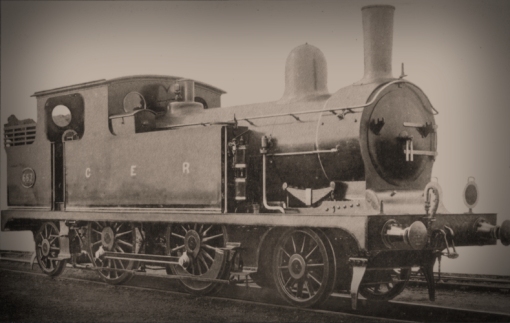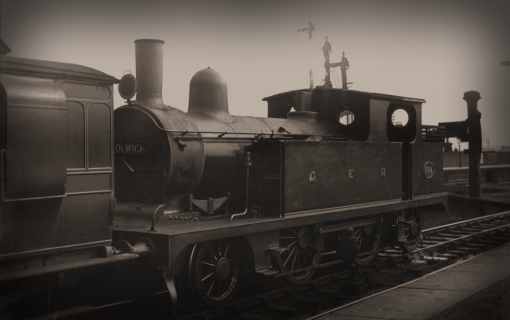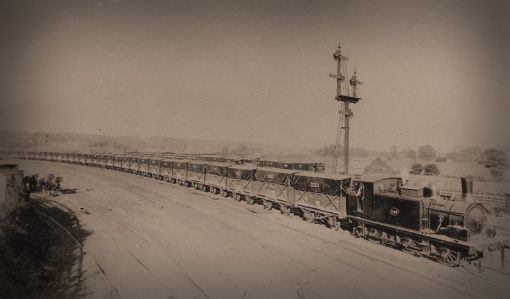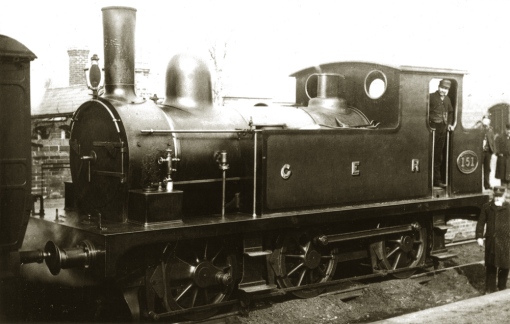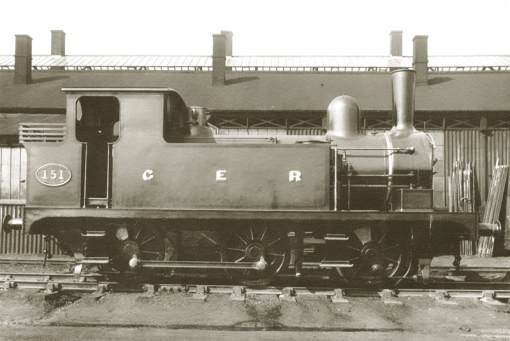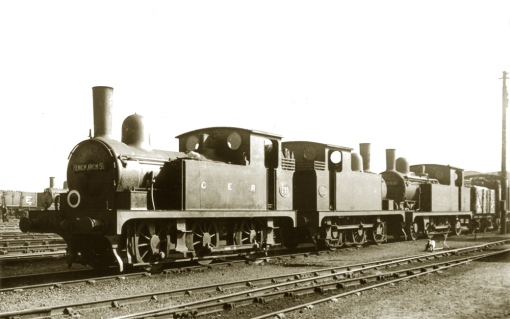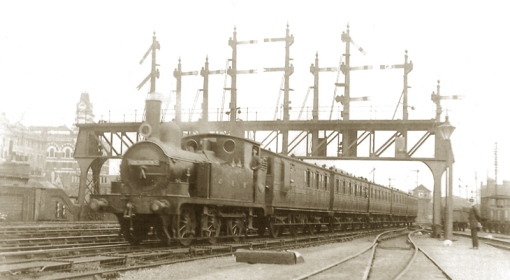In 1893 James Holden introduced a new 2-4-2T specifically designed for fast stopping trains on the increasingly heavy outer suburban services from Liverpool Street. Classified C32 from the Stratford Works Letter Account of the first batch ordered, the new locos were a tank version of Holden’s earlier 5’8” ‘Intermediate’ (GER parlance for Mixed Traffic) 2-4-0s which was in turn a lighter version of his 7’0” express T19 class, the ‘Standards’, which would also lead to the development of the D27 7’0” 2-2-2 ‘Singles’ in the late 1890s.
The C32 class was the epitome of Holden’s standardisation policy, sharing the boiler & firebox, and the arrangement of motion and cylinders with a number of other classes, the trailing and driving wheels with the T26, and of course incorporating the standard contemporary smokebox and Worsdell/Holden boiler fittings shared with all GE locos. As a passenger-rated class it was finished in the ultramarine, black and vermilion livery.
On 29th March 1893, two weeks after the final member of the E22 class 0-6-0Ts (Order B32) rolled off the production line at Stratford Works, the first of the C32s, no.1090, was completed and began trials, after which it was painted in what appears to be ultramarine with white lining rather than the usual French Grey livery used for official photographs.

The official photograph of no.1090 confirms one particularly valuable piece of information in that it was fitted with Holden’s short-lived (in terms of production) side-valve blower, operated via a rod and crank at a break-point on the smokebox in an otherwise continuous handrail. The two-ring boiler, pressed to 140 lbs per square inch has the dome on the front ring in Holden’s usual style with the clack valves directly underneath, and encased two-column Ramsbottom safety valves with the whistle on the valve seat positioned over the firebox. The Westinghouse pump, exhausting into the smokebox , was located on the driver’s side tank front, and three coal rails were fitted from new. Photograph ©Public Domain.
The usual practice in locomotive design was to incorporate the maximum axle loading on the coupled wheelbase, however, in common with the 2-4-0s it was instead over the leading axle, and why Holden chose to do this is not entirely clear. The overall length of the frames was 31’ 9” which was the maximum practically possible for Great Eastern tanks due to the dimensions of the end of platform engine docks at Liverpool Street. This constraint led to the one slight design difference between the C32 and T26 classes, and as we shall see, almost certainly contributed to the tanks’ Achilles heel. To maximise the bunker length and incorporate a coal capacity of 3t 5cwt for their intended duties, the tanks had a 3” shorter leading wheelbase of 7’ 6” with the frames in front of the smokebox correspondingly reduced.
Dispensing with the radial axleboxes favoured by Worsdell for the leading and trailing wheels of his M15 class 2-4-2Ts, Holden copied the double-frame design of the leading axle of his 2-4-0s and installed a similar axle for the trailing wheels, the outer frames forming the valance over the coupled wheels. This feature, along with the 1460 gallon tanks and capacious bunker, contributed to the massive and distinctively brutish appearance of the class.
The carrying axles at each end were double-bearing, incorporating axleboxes fitted to both the inner and outer frames. The inner journals lacked collars which allowed 1” of lateral, uncontrolled sideplay, and in common with the T19 and T26 classes, Holden ensured there was some inbuilt flexibility of the outside frames which allowed them to absorb all of the imparted side forces when the axles reached their limit of travel.

No.1099 is seen with a train of four-wheeled carriages at Romford Factory, the original Eastern Counties Railway Loco Works.The date is before its first rebuilding with a 160psi boiler in 1906. It may have been frowned upon as bad practice, but here’s proof that putting discs on both ends of the loco at the same time actually happened. The discs indicate the service runs between Liverpool Street and Romford, Brentwood, Shenfield or Chelmsford, running on the Through line into and out of Liverpool Street. Up Chelmsford, Shenfield or Chelmsford trains running on the Through line from any point between Romford Junction and Bow Junction inclusive were required to carry “No Distinguishing Discs by day and a white light only under the chimney at night”. Engines running on the Local line between Bethnal Green and Liverpool Street were to carry white-edged green discs or green lights over the buffers only between those two points. Photograph ©Public Domain
Numbers 1090 – 1092, ex Works between 29 March and 17th April, were handed over to the running department between 20th April and 8th May, but within seven days of no.1092 entering service all three were back in Works for what the Stratford Repair Register describes as ‘extra clearance’. Quite how this was achieved isn’t clear, but in practical terms an extra half-inch of sideplay was added to both carrying axles to allow the C32s to traverse the same minimum radius curves as the 2-4-0 classes because it was found that the limit of travel on the trailing axle in either direction was too restrictive.
Numbers 1093-98 were ex-Works 19th April -11th May but the Register notes they had the extra clearance added before they entered service between 15th May and 17th June. Number 1099, ex-Works 16th May had the extra clearance built in during construction and was released to traffic on the same day as no.1098.
A second batch of ten locos, numbers 1070-9 to Stratford Order 033 were built and handed over to the running department between 27th November 1893 and 23rd January 1894. These and all subsequent locos had the 1½” sideplay built in from new.

No. 1085 taken between April 1894 and January 1905. The large condensing pipes fitted to this batch added to their powerful appearance. As with the M15 class, the condensing vent pipes are inside the cab and protrude through the roof. The outside frames haven’t yet suffered the ignominy of a fracture and are so far free of strengthening plates. The cupboard in the lower half of the bunker gives access to the trailing wheel springs. Yet again there’s quite a haze of traffic grime on the paintwork. Photograph ©Public Domain.
The ten locos to Order 033 were immediately followed by another ten to Order R33, numbered 1080-9, which entered traffic between 19th February and 18th April. However this latest order was different from the previous twenty locos as they were fitted with condensing apparatus for running over the East London Railway to New Cross (though I’ve seen no evidence of them being used on this route) and the then new suburban lines out of Liverpool Street which burrowed under the Goods Station at Bishopsgate. Although the condensing gear was deemed necessary in the Up direction on the suburban lines, due to trains often being held by signals in the tunnel for the roads into the terminus to clear – especially during peak hours – it wasn’t the easiest of locations to use the apparatus in the Down direction because the exhaust was directed into the side tanks at a time when it was imperative to have a roaring fire and full head of steam to haul several hundred tons of fully-laden carriages out of the Bishopsgate Low level station up the 1:70 Bethnal Green Bank to the junction. Even with the blower turned on full, the lack of exhaust to aid combustion must have made that section of the journey especially difficult, and drivers suffered the additional problem that condensed steam routed into the side tanks raised the temperature of the water to the point where the injectors ceased to work – feed pumps not being a feature of GER suburban tank design. It’s interesting to note that any official instructions for the use of condensers in the suburban tunnel no longer exist and in later years, long after the LNER repealed the requirement in the 1930s, contemporary drivers later admitted they couldn’t actually remember ever using the equipment there in the GE period!

Number 1084 in the Stygian gloom at Liverpool Street prior to November 1904 when it entered Stratford Works for rebuilding with a 160psi boiler. The paintwork on the tank sides and boiler has been well looked after by the crew, but much of the paint on the smokebox and its door has been completely burnt off under heavy load. The loco displays the simple headcode for an ordinary passenger train. Photograph ©Public Domain
Between July and November 1894, the Repair Register notes that first batch of locos comprising nos.1070-9 were modified by having their frames recessed, but again what exactly is meant, or what it entailed is unclear. It has been suggested the Register implies the frames were somehow dished to clear the carrying wheels, and although it would be an easy modification around the trailing wheels, it’s a mystery as to how this was achieved at the front end due to the presence of the cylinder casting which lay directly behind the leading wheels. The Register is silent on the matter regarding the subsequent batches which suggests the modification had already been implemented during building, though why the first batch had to wait so long to be altered is another unknown.
In December 1894 no.1098 became the first of the class to have control springs fitted to the carrying axles and in January 1895 it was fitted with ‘stronger check springs’, though the Register is silent as to specifics.
Between 1st and 25th May 1895 a fourth batch to Order G35 and numbered 1060-9 were released to traffic. As with the first two batches, these ten locos were not fitted with condensing gear.

No.1060 on a Liverpool Street to Chelmsford fast train leaving Brentwood in May 1908. The first three carriages are fresh out of the carriage repair shops having lost their varnished teak finish and are now painted in the golden brown livery with yellow lining around the windows and upper beading. Photograph ©Public Domain.
During that month, nos.1071 1072 and 1077 were fitted with a ‘new controlling rubber spring arrangement’ although there is no official indication as to what form these control springs took, it would seem the entire class was modified as photographic evidence shows the hornguides of the C32s were deeper than the General Arrangement drawings and the castings fitted to the T19, T26 and D27 classes.
After a gap of seven years a final batch of C32s to Letter Account D53 were ordered. These ten locomotives differed from the earlier forty members of the class by being fitted with a new type of boiler pressed to 160 lbs per square inch, and like the R33 batch, were given condensing apparatus. Numbers 1040-9 were released to traffic between 1st and 25th May 1902.
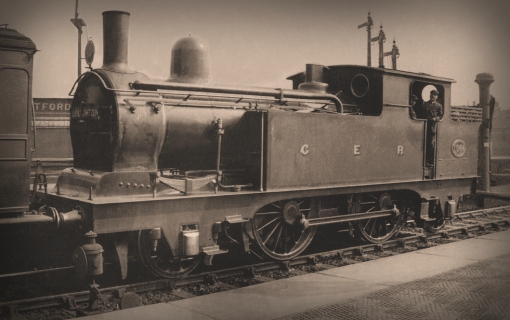
No.1044 was released to traffic on 16th June 1902 and is seen here at Stratford circa 1912 (the year Harrison communication cords were superseded by ‘butterfly’ train alarm gear on the carriage ends) but before May 1914 when it entered Works to be rebuilt. No.1044 has done well to survive thus far without fracturing the outside frames. The destination board reads Loughton and the headcode indicates the service originated at Fenchurch Street. A haze of traffic grime covers the paintwork and the smokebox is in a poor condition. Photograph ©Public Domain.
Beginning with no.1078 in September 1903 and ending with no.1061 in June 1909, the rest of the class were all rebuilt with the 160psi boilers.
A further batch of ten locos were considered and speculatively numbered 1050-9, but with the introduction of the revised M15 class in 1903 was not followed through.
Some years after their introduction, problems arose with stress fractures appearing near the top inboard corner of the carrying hornguides and riveted (later welded) strengthening plates were fitted. This must have come as a bit of a surprise as at this time neither the longer-serving T19 nor the T26 classes suffered from this malady, and although several years later a solitary T19, no.743, rebuilt with a heavier Belpaire boiler (and a consequently higher tractive effort) and several of the T26 class did suffer stress fractures and were correspondingly fitted with strengthening plates. By Grouping all except one of the fifty C32s were given strengthening plates either side of all four axleboxes.
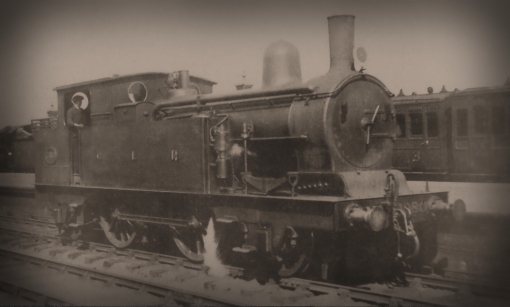
No.1080 at Southend after rebuilding with the 160psi boiler with a strengthening plate riveted to the outside frame behind the front axlebox. The paintwork again has a haze of grime on it, and again the smokebox has been burnt away from being worked hard on the fast outer suburban trains. The loco is showing the headcode for Shenfield and Southend local passenger trains, and the coaching stock behind is a mix of widened and six-a-side suburban 4-wheelers. Photograph © Public Domain.
It may be pertinent to note that the original configuration T19 and D27 classes had a lower tractive effort than the T26 and C32 classes, but it’s likely that the heavy bunker and shorter overhang at the front of the C32s increased the lateral forces when starting away or pulling hard, leading to the high incidence of stress fractures. It’s also interesting to note that all of the photograph’s I’ve managed to locate of the class show the strengthening plates fitted only after the class had been rebuilt with the higher pressure 160lbs boiler, producing a higher tractive effort.
Services
On release to traffic the C32s were all put to work on the heavy outer-suburban fast stopping trains to destinations such as Bishop’s Stortford, Broxbourne, Hertford, Loughton, Southminster and Southend – services which some of the class remained on for many years.

One of my favourite railway photographs of all time! I love the imperfect, dreamy quality of this image taken on a rural stretch of the GE main line to Cambridge which I know so well. As a child I used to spend Thursday evenings after swimming watching trains from just about where those saplings were planted – what I’d give to have seen No.1048 leaving Broxbourne for Liverpool Street with a typically eclectic mix of Victorian 6-wheel stock during the mid-Edwardian period; the nearest carriages are a 32ft Dia.513 brake, a six compartment third to Dia.422, a five compartment first or second to either Dia.105 or 306 built specifically for the Hertford services, and another third after which it all gets a bit fuzzy! The covered footbridge linking the station platforms can be seen in the distance, a view which would be blocked from 1908 with the building of a new road overline bridge immediately south of the station. The headcode indicates the fast service from Hertford stops at Broxbourne, Cheshunt and then on to Liverpool Street via either Clapton to the suburban lines (for which the condensing-equipped loco is suited) or Stratford and the Through or Local lines (where it passes through Basilica Fields) to the terminus. Any loco hauling a Special service going via Stratford and taking the Through lines between Bethnal Green and Liverpool Street was required to show two more white-edged green discs on the middle and left-hand lamp irons between those stations. Photograph ©Public Domain.
Modelling the class
In 7mm no commercial kit exists or has ever existed, which is surprising considering the popularity of the T26. However, that top man Colin Dowling has come to the rescue by making available highly accurate profile milled parts for the body and frames and I’ll be building one of the condensing series for Basilica Fields.
Sources
This entry would have been very poor indeed were it not for the following rich seams of information:
- Locomotive Mysteries: Side Control Springs – Lyn D. Brooks, Great Eastern Society Journal #52
- Side Control Springs: An addendum – Lyn D. Brooks, Great Eastern Society Journal #55
- Great Eastern Locomotive Mysteries: Condensing Gear – Lyn D. Brooks, Great Eastern Society Journal #62
- Locomotives of the LNER Part 7 – RCTS
- Yeadon’s Register of LNER Locomotives Vol.39
- Great Eastern Locomotives Past and Present – C Langley Aldrich
- GER Appendix to the Working Timetable 19, January 1906




